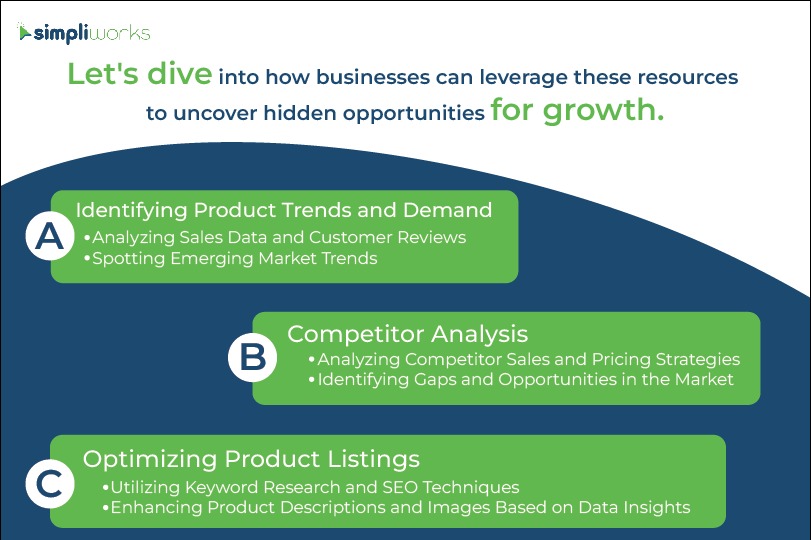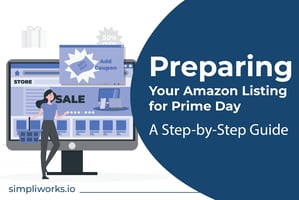Managing your Amazon seller account effectively is crucial for success in the highly competitive...
Finding Hidden Opportunities with Amazon Data and Analytics
In today's highly competitive business landscape, data and analytics have become powerful tools for driving growth and gaining a competitive edge. One platform that offers a vast data ecosystem is Amazon, the world's largest online marketplace. In this article, we will delve into the various types of data available on Amazon, explore the analytics tools provided by the platform, and discuss how businesses can leverage this data to uncover hidden opportunities for growth.

Understanding Amazon Data
To fully utilize Amazon's data ecosystem, it is essential to understand the different types of data available. By tapping into these data sources, businesses can gain valuable insights that can drive their decision-making processes.
- Sales Data
Sales data is at the core of Amazon's data ecosystem. It provides businesses with a comprehensive view of their product performance, including information on revenue, units sold, and profit margins. Analyzing sales data allows businesses to identify top-performing products, track sales trends, and make data-driven decisions to optimize their product offerings.
- Customer Data
Amazon collects vast amounts of customer data, ranging from demographic information to purchasing behavior. By analyzing this data, businesses can gain a deep understanding of their target audience, identify customer preferences, and tailor their marketing strategies to better resonate with their customers. Customer data also enables businesses to personalize their offerings, resulting in enhanced customer satisfaction and loyalty.
- Competitor Data
In addition to internal data, Amazon provides valuable insights into competitor performance. Analyzing competitor data, such as sales volumes and pricing strategies, allows businesses to benchmark themselves against their competitors and identify areas where they can gain a competitive advantage. By understanding their competitors' strengths and weaknesses, businesses can refine their own strategies and seize untapped market opportunities.
- Market Trends and Insights
Amazon's data ecosystem also offers access to market trends and insights. By monitoring market trends, businesses can identify emerging product categories, spot shifts in consumer preferences, and adapt their offerings accordingly. Staying ahead of market trends enables businesses to position themselves as industry leaders and capitalize on new opportunities before their competitors.
Read our latest article: Why Should You Hire an Amazon Account Management Company?
Leveraging Amazon Analytics Tools
To harness the power of Amazon's data ecosystem, businesses can utilize various analytics tools provided by the platform. Let's explore some of the key tools and functionalities available.
A. Introduction to Amazon Seller Central
Amazon Seller Central is a comprehensive platform that allows businesses to manage their Amazon-selling accounts. It provides a range of features and functionalities that are crucial for accessing and analyzing valuable data.
- Key Features and Functionalities
Seller Central offers features such as inventory management, order fulfillment, and customer communication tools. These features enable businesses to streamline their operations and improve their overall selling performance. Moreover, Seller Central serves as a hub for accessing vital data and analytics that can drive business growth.
- Using Seller Central to Access Valuable Data
Within Seller Central, businesses can access a wealth of data, including sales reports, customer feedback, and performance metrics. By regularly analyzing this data, businesses can track their progress, identify areas for improvement, and make informed decisions to optimize their Amazon selling strategies.
B. Amazon Advertising and Sponsored Products
Amazon Advertising provides businesses powerful tools to promote their products and reach a wider audience. Leveraging these advertising campaigns not only helps businesses increase visibility but also provides valuable data insights.
- Utilizing Advertising Campaigns for Data Insights
Amazon Advertising allows businesses to create targeted advertising campaigns, enabling them to reach their desired audience segments effectively. By analyzing the performance of these campaigns, businesses can gain insights into consumer behavior patterns, identify which products resonate the most with their audience, and adjust their marketing strategies accordingly.
- Identifying Consumer Behavior Patterns through Sponsored Products
Sponsored Products, a popular advertising feature on Amazon, offers businesses the opportunity to showcase their products at the top of relevant search results. By running Sponsored Products campaigns and analyzing the data, businesses can gain insights into the keywords, customers use to find their products, the click-through rates, and conversion rates. This information helps businesses refine their keyword strategies, optimize product listings, and drive more targeted traffic to their offerings.
C. Amazon Web Services (AWS) for Data Analytics
Amazon Web Services (AWS) provides a suite of powerful tools and services that enable businesses to perform advanced data analytics. By leveraging AWS, businesses can unlock the full potential of their data and extract actionable insights.
- Overview of AWS Capabilities
AWS offers a wide range of data analytics services, including Amazon Redshift for data warehousing, Amazon Athena for ad-hoc querying, and Amazon QuickSight for data visualization. These services empower businesses to perform complex data analysis, identify trends, and make data-driven decisions.
- How to Leverage AWS Tools for Data Analysis
By integrating Amazon data with AWS services, businesses can perform sophisticated analyses, such as predictive modeling, customer segmentation, and sentiment analysis. These advanced analytics techniques help businesses uncover hidden patterns, gain a deeper understanding of their customers, and optimize their strategies for maximum impact.
Uncovering Hidden Opportunities
Now that we have explored the types of data available on Amazon and the analytics tools. Let's dive into how businesses can leverage these resources to uncover hidden opportunities for growth.

A. Identifying Product Trends and Demand
Analyzing sales data and customer reviews is an effective way to identify product trends and gauge demand. By examining sales performance over time, businesses can identify products with consistent growth, as well as those experiencing declining demand. Customer reviews provide valuable insights into product satisfaction, allowing businesses to refine their offerings and address any pain points.
- Analyzing Sales Data and Customer Reviews
To analyze sales data effectively, businesses can leverage visualizations such as line graphs and bar charts. These visual representations help identify sales trends, seasonality patterns, and overall growth rates. Additionally, sentiment analysis of customer reviews can provide businesses with valuable feedback on product quality, features, and areas for improvement.
- Spotting Emerging Market Trends
By monitoring market trends and analyzing sales data, businesses can identify emerging product categories or niches. This allows them to stay ahead of the competition and capitalize on new opportunities before they become saturated. Understanding consumer preferences and market dynamics helps businesses make informed decisions about expanding their product offerings and entering new markets.
B. Competitor Analysis
Analyzing competitor data is crucial for gaining a competitive advantage and identifying gaps and opportunities in the market. By understanding how competitors position themselves, what pricing strategies they employ, and how their products are performing, businesses can fine-tune their own strategies and stand out from the crowd.
- Analyzing Competitor Sales and Pricing Strategies
By examining competitor sales data, businesses can identify products that are performing well in the market. This information can help businesses evaluate their own product offerings, optimize pricing strategies, and identify areas where they can differentiate themselves. By offering unique value propositions and competitive pricing, businesses can attract customers and capture a larger market share.
- Identifying Gaps and Opportunities in the Market
Competitor analysis also allows businesses to identify gaps in the market where there is limited competition or unmet customer needs. By analyzing competitor offerings, businesses can uncover underserved segments and develop products or services tailored to those specific needs. This strategy positions businesses as innovative leaders and opens up new revenue streams.
Also Read: 10 Proven Steps for Profitable Amazon Account Management
C. Optimizing Product Listings
Optimizing product listings is essential for improving visibility and attracting potential customers. By leveraging keyword research and SEO techniques, businesses can ensure that their product listings are well-optimized and appear in relevant search results.
- Utilizing Keyword Research and SEO Techniques
Keyword research plays a crucial role in optimizing product listings. By identifying relevant keywords with high search volume and low competition, businesses can improve their chances of appearing in top search results. Incorporating these keywords naturally in product titles, descriptions, and backend metadata helps increase visibility and drives organic traffic to the listings.
- Enhancing Product Descriptions and Images Based on Data Insights
Analyzing customer data and feedback can provide businesses with valuable insights into what customers find appealing. By incorporating these insights into product descriptions and images, businesses can create compelling content that resonates with their target audience. High-quality images, detailed product descriptions, and customer-centric messaging contribute to higher conversion rates and improved customer satisfaction.
Conclusion
In conclusion, the power of data and analytics in business cannot be overstated, and Amazon's vast data ecosystem provides businesses with a treasure trove of insights and opportunities. By understanding the various types of data available, leveraging Amazon's analytics tools, and utilizing data-driven strategies, businesses can unlock hidden opportunities for growth.
Unleash your Amazon account's potential. Contact us for expert account management that drives growth and success. Let's elevate your Amazon business together.






